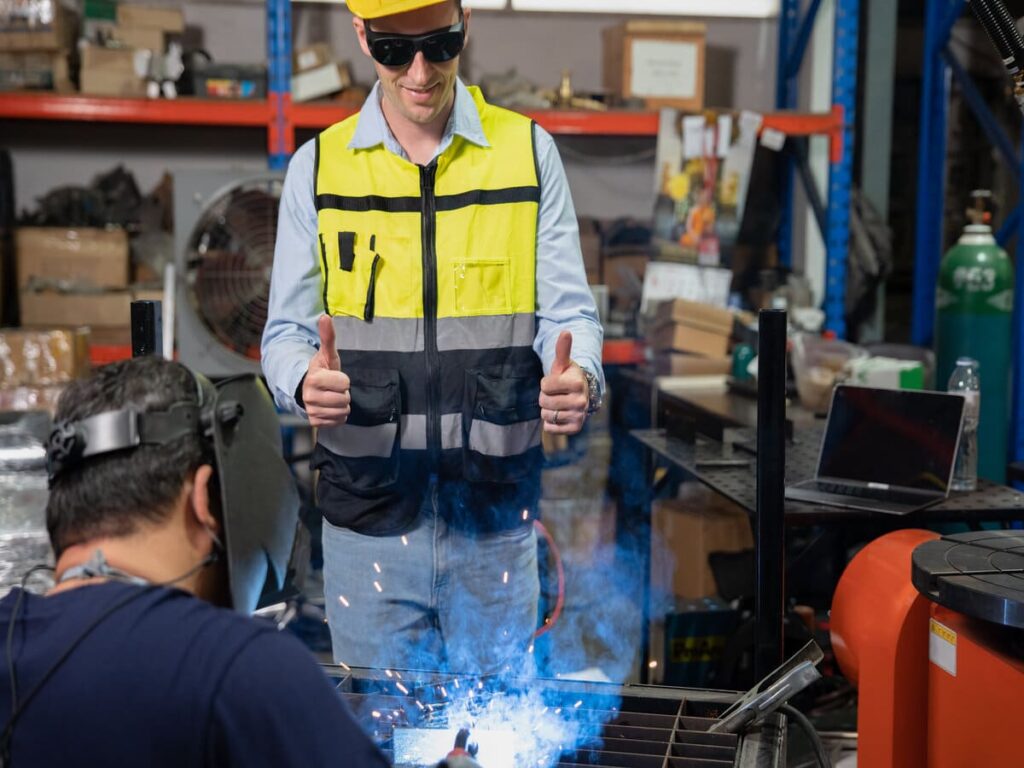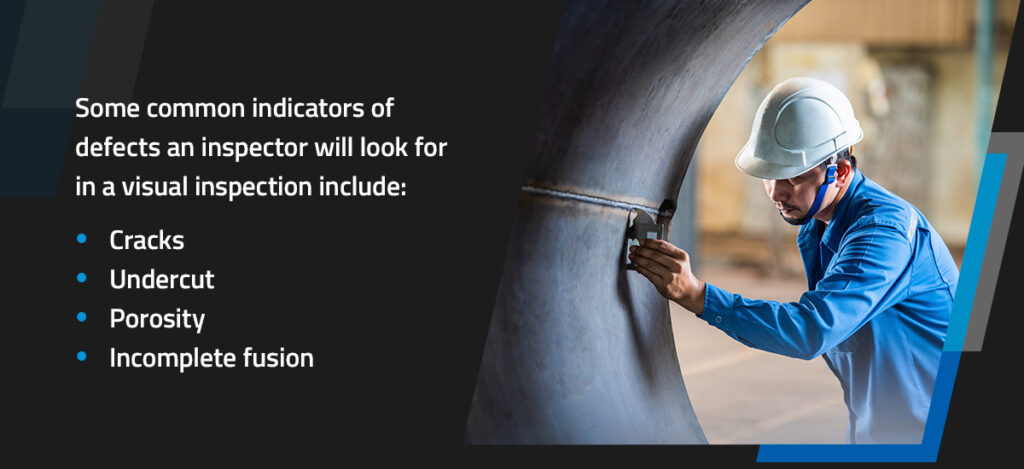How Welding Inspection Racine Makes Sure Safety And Security and Conformity
How Welding Inspection Racine Makes Sure Safety And Security and Conformity
Blog Article
Cutting-edge Approaches to Fillet Weld Evaluation and Testing: Enhancing Weld Quality and Compliance Criteria
In the realm of welding, the quality and honesty of fillet welds play an important role in making certain the structural sturdiness and integrity of different industrial parts. With the constant drive for boosted performance and compliance with rigorous requirements, the exploration of cutting-edge strategies to fillet weld assessment and testing has actually become imperative.
Advanced Non-Destructive Testing Approaches
Using modern technologies, progressed non-destructive testing techniques play a critical duty in making sure the integrity and high quality of fillet welds. These approaches, such as phased range ultrasonic screening (PAUT) and magnetic particle testing (MPT), deal thorough insights into the weld's inner framework without causing any damage to the product. PAUT, for circumstances, utilizes several ultrasonic components to evaluate the weld from numerous angles, providing a detailed visualization of possible defects like lack of combination or fractures.
By utilizing these sophisticated non-destructive screening strategies, weld assessors can precisely examine the high quality of fillet welds, guaranteeing compliance with sector criteria and guidelines. The capability to spot defects early on not only enhances weld quality yet likewise avoids costly rework or failings in structural integrity, underscoring the relevance of these innovative testing approaches in welding examinations.
Robotics and Automation in Assessment
The integration of robotics and automation has actually reinvented the evaluation procedure for fillet welds, improving efficiency and precision in high quality analysis. Robotics use precise control and repeatability in evaluating welds, guaranteeing trustworthy and consistent results. Automated systems can be programmed to adhere to particular examination paths, ensuring complete coverage of welds and lowering the risk of human error.
Robot examination systems geared up with innovative sensors can identify and determine weld attributes with high precision, supplying detailed data for evaluation. These systems can identify issues such as cracks, absence of fusion, and porosity, enabling timely restorative activities to be taken. Furthermore, robotics and automation permit for real-time information collection and analysis, giving immediate feedback to drivers and assisting in fast decision-making processes.
Additionally, using robotics and automation in fillet weld examination improves overall efficiency by lowering examination times and increasing evaluation throughput. By enhancing the assessment procedure, suppliers can make certain weld quality and compliance standards are met efficiently, ultimately resulting in cost savings and improved product quality.
Utilizing Expert System for Analysis
Synthetic intelligence plays a critical function in improving the effectiveness and accuracy of analysis in fillet weld evaluation processes. By harnessing the power of AI, inspectors can simplify the evaluation of weld top quality and conformity requirements, resulting in more precise and dependable results. AI algorithms can rapidly refine vast quantities of information from weld evaluations, discovering problems or inconsistencies that might be challenging to understand the nude eye. This innovative innovation enables real-time surveillance of weld top quality, enabling instant corrective activities to be taken if any concerns are found.
In addition, AI systems can pick up from past examination data, continuously boosting their ability to determine possible defects and variances in fillet welds. This flexible learning capability improves the total quality control process, minimizing the chance of human error and guaranteeing that welds satisfy the called for standards. By integrating synthetic knowledge right into fillet weld evaluation, sectors can achieve higher levels of effectiveness, uniformity, and conformity in their inspection practices.
Portable Equipment for On-Site Assessment
 Enhancing field evaluation performance, the fostering of mobile tools transforms on-site analysis procedures for fillet welds. These devices provide versatility and comfort, permitting assessors to perform comprehensive assessments in different places, including remote or difficult atmospheres. Portable tools such as ultrasonic testing devices, magnetic bit examination equipment, and electronic radiography systems offer real-time data and high-resolution imaging abilities, allowing quick decision-making and instant responses on weld high quality.
Enhancing field evaluation performance, the fostering of mobile tools transforms on-site analysis procedures for fillet welds. These devices provide versatility and comfort, permitting assessors to perform comprehensive assessments in different places, including remote or difficult atmospheres. Portable tools such as ultrasonic testing devices, magnetic bit examination equipment, and electronic radiography systems offer real-time data and high-resolution imaging abilities, allowing quick decision-making and instant responses on weld high quality.One considerable advantage of portable devices is their capacity to simplify examination procedures, minimizing downtime and boosting general performance. Assessors can quickly move these devices to different work websites, getting rid of the requirement for transferring heavy equipment or elements to off-site facilities. Additionally, the transportability of visit this website these devices promotes cost-effectiveness by minimizing transport costs and accelerating examination timelines.
In addition, using portable devices for on-site evaluation advertises positive quality assurance measures, as examiners can quickly recognize and attend to any possible welding problems or disparities. By integrating these innovative innovations into on-site assessment practices, welding specialists can ensure conformity with industry requirements and enhance weld high quality, inevitably causing improved structural honesty and safety in numerous welding applications.
Integration of Data Monitoring Solution
Having actually optimized on-site assessment procedures through the use of mobile tools, the next stage entails the seamless combination of information monitoring systems to even more boost performance and data analysis capacities in fillet weld inspection and testing. Welding Inspection Racine. By integrating information monitoring systems right into the inspection process, organizations can streamline data collection, storage space, and analysis. This integration permits real-time tracking of weld top quality, prompt recognition of defects, and prompt decision-making to correct any type of problems that might emerge throughout the inspection process
The integration of data monitoring systems allows smooth communication in between different stakeholders entailed in the evaluation procedure, promoting partnership and boosting total quality control procedures. Eventually, the combination of information administration systems offers to raise the criteria of fillet weld evaluation and testing, making sure compliance with market guidelines and boosting weld quality.
Verdict
To conclude, cutting-edge approaches to fillet weld examination and testing have actually considerably improved weld top quality and compliance standards. Advanced non-destructive screening approaches, robotics, automation, artificial intelligence, portable devices, and information management systems have reinvented the means weld inspections are conducted. By using these innovations, sectors can make certain that welds meet the required high quality requirements and guidelines, inevitably boosting total performance and safety and security in welding processes.

By employing these innovative non-destructive screening techniques, weld inspectors can accurately assess the high quality of fillet welds, guaranteeing compliance with industry standards and regulations. Mobile devices such as ultrasonic screening gadgets, magnetic bit examination devices, and digital radiography systems offer real-time data and high-resolution imaging capabilities, making it possible for quick decision-making and prompt responses on weld quality.
Having enhanced on-site inspection processes via the use of portable devices, the next phase involves the smooth assimilation of data management systems to further boost effectiveness and data evaluation capabilities in fillet weld inspection and testing (Welding Inspection Racine). Ultimately, the integration of information administration systems offers to raise the standards of fillet weld examination and testing, straight from the source ensuring conformity with market laws and improving weld quality
 In final thought, ingenious approaches to fillet weld examination helpful resources and testing have actually substantially improved weld top quality and compliance standards.
In final thought, ingenious approaches to fillet weld examination helpful resources and testing have actually substantially improved weld top quality and compliance standards.Report this page